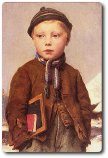Songs of Innocence and Experience Contents
The Schoolboy - Imagery, symbolism and themes
Imagery and symbolism
This poem depends upon three inter-related images, the schoolboy, the bird and the plant. All three are dependent upon, or vulnerable to, the way in which they are treated by human beings.
 Schoolboy - The image of the child here focuses on his nature as free and unfettered. He is associated with the spring as a time for growth, freshness and playfulness. As such, the child represents the playful, free nature of the creative imagination. According to Blake, this was fettered by subjection to the demands of a system which denies the validity of imagination. In The School Boy, formal education involves subjection to a ‘cruel' eye and cruelty in Blake is always linked with the denial of imaginative freedom and of the spiritual self.
Schoolboy - The image of the child here focuses on his nature as free and unfettered. He is associated with the spring as a time for growth, freshness and playfulness. As such, the child represents the playful, free nature of the creative imagination. According to Blake, this was fettered by subjection to the demands of a system which denies the validity of imagination. In The School Boy, formal education involves subjection to a ‘cruel' eye and cruelty in Blake is always linked with the denial of imaginative freedom and of the spiritual self.
Bird - The bird imagery allows for the comparison between the free child being imprisoned in school and the songbird being caged. The unity between bird and boy is emphasised in stanza one. The sky-lark ‘sings with me'. This inverts our expectations. We tend to think of the sky-lark as the primary singer, with whom people might sing along. Here, however, it is the child who is the first singer. It is as natural to him as to the lark, as though he were another bird.
Birds are also images of freedom. Their capacity for flight and for song makes them appropriate images of creative imagination, since poets ‘sing' and imagination is often linked with the notion of flight. The schoolboy in school and the bird in the cage are, therefore, seen as equivalents not only at the natural level, under physical subjection, but at the spiritual level, too. Both represent the caging and entrapping of imaginative vision.
Plant - The image of the plant applies to the school boy's present and future. The young plant, like the young child, is tender and vulnerable. The way it (and the child) is treated at this stage dictates its later capacity to bear fruit. Just as food gathered in autumn is necessary to ensure survival through the winter, so experiences of joy and the freedom of the imagination are necessary for a person's capacity to live well and survive the inevitable ‘griefs' of life.
Investigating imagery and symbolism
- How effective do you find the comparison of a child to a bird and a plant?
Themes
The nature and vulnerability of innocence
Innocence is presented here as freedom from constraint and self-consciousness. The child starts out taking pleasure in an uninhibited life, full of trust in his world, both natural and human. The fragility of this state is clear from images like ‘blossoms' and ‘tender plants .. strip'd'. The child soon experiences the ‘woe' in life and of learning the possibility of failure and betrayal.
Snares, confinement
Images of confinement abound in the Songs. Blake the revolutionary opposed the coercive strictures of the ‘Establishment' – the state, organised religion etc. - which sought to quantify and rule all aspects of human behaviour. Here, education is formalised and restrictive, actually stunting the development of those it claimed to nurture. Prison imagery is seen in the ‘cruel eye' of the overseer and the ‘cage' of the bird.
The perception of children
- Is the child born free and good, as Rousseau believed, or born sinful, as the Calvinist Christians believed?
- Or is this opposition the result of fallen human beings' inability to recognise that the capacity for good and evil both belong to humanity?
Blake's idea that a young child can clearly see God echoes the Romantic sensibility articulated by Wordsworth, that children had an existence in heaven before the commencement of their earthly life. See The world of the Romantics > Making sense of the intangible world > Seventeenth and eighteenth attitudes to childhood.
Blake saw the natural child as an image of the creative imagination which is the human being's spiritual core. He was concerned about the way in which social institutions such as the school system and parental authority crushed the capacity for imaginative vision. The child's capacity for happiness and play are expressions of this imagination.
Parental care and authority
In Blake's work, parents are often perceived as inhibiting and repressing their children. Their own fears and shame are communicated to the next generation through the parental desire to ‘protect' children from their desires. According to Blake, parents misuse ‘care' to repress children, rather than setting the children free by rejoicing in, and safeguarding, their capacity for play and imagination. Here, parents are seen as colluding with a repressive system; it is as though they are entrapped by a way of seeing the world and transmit that entrapment to their offspring by perpetuating the system.
Investigating themes
- Blake moved this poem from the Songs of Innocence.
- For what reasons do its themes make it appropriate as a Song of Experience?
Related material
Scan and go

Scan on your mobile for direct link.